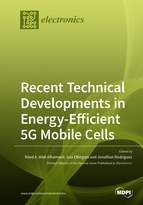Recent Technical Developments in Energy-Efficient 5G Mobile Cells
A special issue of Electronics (ISSN 2079-9292). This special issue belongs to the section "Microwave and Wireless Communications".
Deadline for manuscript submissions: closed (31 December 2019) | Viewed by 95110
Special Issue Editor
Interests: energy-efficient front-end design; radio frequency; energy harvesting; communications systems; 5G communications; sensor design; localisation-based services; signal processing; optimisation process; MIMO system design; health hazards; propagations, antennas and electromagnetic computational techniques
Special Issues, Collections and Topics in MDPI journals
Special Issue Information
Dear Colleagues,
At present, 4G systems provide a universal platform for broadband mobile services. However, mobile traffic is still growing at an unprecedented rate, and the need for more sophisticated broadband services is pushing the limits of the current standards to provide an even tighter integration between wireless technologies and higher speeds. The change in the nature of services and devices, along with pressures on the operation and capital costs put stringent limits on the design of mobile networks. Moreover, energy efficiency is now at the forefront of the socio-economic agenda, creating market drivers towards energy compliant handsets and networking devices.
This has led to the need for a new generation of mobile communications, the so-called 5G. Although 5G systems are not expected to penetrate the market until 2020, the evolution towards 5G is widely accepted to be the logical convergence of internet services with existing mobile networking standards, leading to the commonly used term “mobile internet” over heterogeneous networks, with very high connectivity speeds.
This Special Issue aims to narrow the gap between the current networking technologies and the foreseen requirements that are targeted at the future development of the 5G mobile and wireless communications networks in terms of the following:
- higher networking capacity
- ability to support more users
- lower cost per bit
- enhanced energy efficiency
- adaptability to new services and devices (examples, smart cities, and the Internet of things (IoT)).
Specific Topics
It is expected that the future mobile networks will be built using small cells (such as femto, pico, and relay) and heterogeneous cells, which include WiFi hotspots, among others. The dense deployment of these cells and their coexistence are all new and important research challenges for future 5G and beyond. Submissions can focus on the conceptual and applied research in topics including, but not limited to, the following:
- Energy efficient and multi-standard RF front-end
- Network coded cooperation for mobile cells
- Reconfigurable or multimode RF spectrum operation
- MIMO/mMIMO for 5G mobile networks
- Reconfigurable antenna array for 4G/5G handsets and base stations
- High-speed and energy-efficient connectivity on demand
- Secure networking coding for mobile small cells
- Enabling mobile small cells and network virtualization
- 5G small cells technologies and applications
- Emerging the IoT applications with the new 5G developments.
Submissions should be of high enough quality for an international journal, and should not be submitted or published elsewhere. However, the extended versions of conference papers that show significant improvement (minimal of over 30%) can be considered for review in this Special Issue. In addition, we welcome review papers covering the subjects of this Special Issue.
Technical Program Committee Members:
- Prof. Peter Excell Wrexham University
- Prof. Jonathan Rodriguez South Wales University
- Prof. Simon Shepherd University of Bradford
- Prof. Irfan Awan University of Bradford
- Prof. Rami Qahwaji University of Bradford
- Dr. Issa Elfergani Instituto de Telecomunicações, Averio, Portugal
- Dr. James M Noras University of Bradford
- Dr. Chan H See University of Bolton
Prof. Dr. Raed Abd-Alhameed
Guest Editor
Manuscript Submission Information
Manuscripts should be submitted online at www.mdpi.com by registering and logging in to this website. Once you are registered, click here to go to the submission form. Manuscripts can be submitted until the deadline. All submissions that pass pre-check are peer-reviewed. Accepted papers will be published continuously in the journal (as soon as accepted) and will be listed together on the special issue website. Research articles, review articles as well as short communications are invited. For planned papers, a title and short abstract (about 100 words) can be sent to the Editorial Office for announcement on this website.
Submitted manuscripts should not have been published previously, nor be under consideration for publication elsewhere (except conference proceedings papers). All manuscripts are thoroughly refereed through a single-blind peer-review process. A guide for authors and other relevant information for submission of manuscripts is available on the Instructions for Authors page. Electronics is an international peer-reviewed open access semimonthly journal published by MDPI.
Please visit the Instructions for Authors page before submitting a manuscript. The Article Processing Charge (APC) for publication in this open access journal is 2400 CHF (Swiss Francs). Submitted papers should be well formatted and use good English. Authors may use MDPI's English editing service prior to publication or during author revisions.
Keywords
- 5G
- Antennas and Propagation
- Energy Efficient
- Internet of Things (IoT)
- MIMO
- Network Coded Cooperation
- Network Security
- Network Virtualization
- Radio Frequency and Reconfigurable Spectrum
- Small Cell Technology






